Introduction for the interactive artifact——The Mirror
by Yuan, Jiaxiang of Group E
The Idea
by Cheah, Nicole
The imaginary interactive artifact I would create for the short story, “The Ones Who Walk Away from Omelas” by Ursula K. Le Guin, would be an interactive two-sided ‘mirror’ art piece that would be placed in the middle of the city of Omelas. I think the city is described as one that is quite happy on the surface, but a city that has a dark secret that lies underground– a child who suffers at the expense of everyone’s (citizens of Omelas) happiness. I think placing this ‘interactive mirror’ in the city, would be more-so a surprising exhibition that would shock townspeople as the child’s suffering is one that is known to all people but not spoken of. The guilt of this moral dilemma consumes certain people in the town and leads them to disappear and walk away to an unknown place– however, the installation of this ‘mirror’ could help create dialogue and open-reflection amongst the townspeople and help them confront the ethical problem that is directly tied to the child’s suffering. To describe this ‘mirror’ in further detail, I think it is an artifact that on one side will show the city as it is normally (happy on the surface, while everyone being ignorant of the child’s misery), and on the other side a visual of the amount of pain the child suffers on a day-to-day basis. The artifact encourages some sort of introspection for the citizens, and I believe would be something that could wake the citizens up in confronting the moral dilemma the town faces. Despite me saying before, how this ‘mirror’ can perhaps prompt conversation and dialogue between the townspeople as the subject is like the ‘elephant in the room’– a potential problem that may be caused by the controversial exhibition and interactive artifact could be an overwhelming sense of guilt that may be felt by the citizens when seeing and interacting with the piece. As the child lives underground –under the city– the citizens may not know or have ever visualized how bad the conditions are for this one child– this artifact, thus, I feel, has the risk to make more people want to walk off into the unknown land. I think that there are many artifacts, and in-fact, art exhibitions that act similarly to this interactive artifact for the town of Omelas. The article I have linked below from Goodness Exchange, shows an exhibition of an NYU Associate Arts Professor and Israeli American artist’s work (that of Daniel Rozin). He creates mechanical mirrors out of strange materials that reflect a “new reflection” (Allerton) of the person looking into it. I think this project is extremely interesting and eye-opening as I feel like the technology Rozin has created is kind of an inspiration of what I would like to base my artifact off of, as the mirror for Omelas is supposed to reflect a kind of ‘alternate reality.’ Instead of showing a different or per-say new reflection of a person, like the work of Rozin’s, I feel like the interactive artifact for Omelas would more-so reflect what I mentioned before; the dichotomy between the happy city and the child’s suffering– a citizen would see these visualizations when peering into the mirror.
The Final artifact
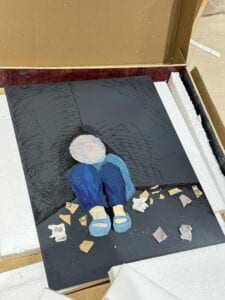
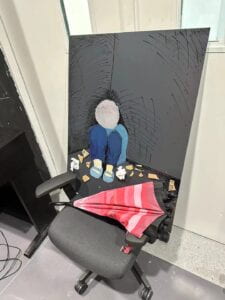
The front of the artifact paints the extremely sad boy and the back of the artifact is the mirror.
The Performance
The Script
by O’Brien, Roman
It starts with the boy being bullied for a little bit.
Boy: “Please, I’ll be good, I promise I’ll be good
Bully: Shut up, filthy. You disgust me, you represent everything that is wretched.
[bully walks off stage]
boy, alone: But I’ll be good.
On the stage everyone stands with a partner whispering to them, the microphone is positioned so that the audience can hear the vague whispers and gossip.
They whispers stop as the focus is shifted onto the mirror in the center of the stage.
Someone at the side where the audience can’t see: ‘hurry up we have to get to the festival.’
12: ‘Okay okay let’s go.’
[skipping with an 8-year-old across stage until they see the mirror, maybe there’s bells chiming or they’re laughing or something and then they stop when they see the mirror]
8: I’ve never seen this mirror before
12: Do you see that? Inside, in there! It’s a boy!
[points]
8: Quick Quick we have to get him out
12: [ name of 8-year-old] we can’t
8: What do you mean we can’t?
12: I’ve seen him before, hasn’t your mom told you about him?
8: No… but why can’t we let him out?
[pause]
12: Think about it like this: You’re happy, right?
8: Well, sure of course
12: How do you know?
8: [shrugs]
12: When you see that boy, you know.
8: But he’s just like me, why can’t I be his friend? 🙁
12: [frantic] Hey hey! look! when you frown, I can’t see him…
8: Oh… But every time I smile because of something that makes me happy he comes back.
12: I wonder who put this mirror here, I’m not sure I like the way it makes me feel …
Horse: What are you kids doing here? Quickly, go up to the Green Fields for the procession.
12: yea, we should do that. Quickly [ name of 8-year-old], c’mon
[ walk off stage]
Horse, talking to himself/horse: Oh, what a lovely day it is to be joyous. What a lovely life . . . easy, quiet girl, can’t you see the beauty of the world around you? It’s the first day of summer, and the sun is shining so. What a gift it is to know joy.
Horse: Come with me, observe the beauty of your mane in the reflection.
[stands in front of the mirror]
[slowly realizes and gets disgusted]
[kids come back with their parents]
[parent one steps up, kids and parent two talk in a little circle farther on stage]
Horse: have you seen this mirror, this monstrosity?
Parent 1: The children were just telling us about it, but sir it isn’t so bad is it . . . It’s not as if you didn’t know.
Horse: yes, I knew, but do you think it should just be out like this . . . wouldn’t you rather forget at times?
Parent 1: Well, sure, but we shouldn’t
Horse: Look at me, aren’t I the picture of joy? Exuberance? And my horse, don’t you think thinking about . . . it. . . that, takes away from the festivities?
Parent 1: I think you should be wary of vapid irresponsible happiness, lest you end up like him, unable to be helped. . .
[bully enters again, kicking and spitting on kid in the mirror] [people watch in shock] [bully walks around stage as if to walk out of building and towards town square]
Bully: Shouldn’t you all be out enjoying life?
Horse: look, this mirror, we just saw you through it
Bully: ugh, not that poor wretched thing
Horse: I suppose so . . .
Bully: I think it’s good to go and give it a good kick sometimes, keep things in order
Horse: wouldn’t you rather just forget it exists at all?
Bully: don’t you understand you can’t just forget about it? You need to hurt it. You can’t let it know that it is important or even cared for, that will ruin everything.
Parent 2: you’re supposed to take those feelings and put them in your own children, don’t you understand?
Parent 1: This is just the way things are.
Bully: This mirror shows you how the world works
Horse: I do understand but I don’t like it, it horrifies me . . . I don’t think I can stay here, are we not just prisoners?
Parent 2: Maybe we are . . . but you can’t just leave Omelas. Too many young people have just left and never returned. You don’t know where you’re going, and it could be dangerous out there.
Horse: But how can I stay when I know that this is happening, when this mirror reminds me of the reality every time, I am happy?
Parent 2: [exasperated] Why can’t you honor this boys sacrifice?
Horse: Because it is wrong
Parent 2: If that is wrong then all of our joy, the nobility of their architecture, the poignancy of our music, the
profundity of our science is also wrong.
Horse: I cannot agree with you
Parent 2: I cannot agree with you either, but please stay.
8: please don’t go away
12: please don’t walk away from Omelas
Horse: I’ll stay
Parent 2: I’ve never been able to talk about the boy with anyone before, I try to just forget it like you, but no one here wants to ignore it anymore.
12: maybe being able to talk about it is a good thing?
8: I think so too
Horse: maybe this mirror is what the people of Omelas need
Parent 2: There’s a chance it could make more people try to walk away, like you, but there’s also a chance that it makes people talk about the truth more.
Bully: [interjecting/interrupting, purposefully sounds awkward/ruins sentimental moment] SOOO…. Do you guys want me to move this from the middle of town or…?
Parent 1: No, no, I think you should leave it.
Horse: Yes, I agree, please leave it right there.
Props
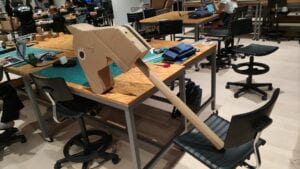
A horsehead made by cardboard.
My Opinion on Our Artifact
I think the failure of our artifact is that we didn’t build a stand for it so that it can turn around without the help of the turning chair. Without the stand, our artifact seemed less interactive to the audience.
If I could make improvement to the artifact, I would not completely stick the mirror and the painting together. Instead, I would only stick the two parts at the top, so that the turning chair wouldn’t block the view of some parts of the artifact.
I think the success of our artifact is that we clearly demonstrated the purpose and interaction of the mirror through our elaborate script. We showed the audience that the mirror turns whenever there is joy to reveal the cruel truth under the happiness of Omelas and different people’s perspectives and opinions on the mirror and the imprisoned, bullied and mistreated kid.
I define interaction as two or more humans, animals or non-living things input, process and output information with each other in a way both of them can sense. I think the artifact relates to the established form of interaction I identified in my research. The mirror can sense people’s mood and decide whether to turn or not, and the thoughts of users change when the mirror turns, which leads them to stay, reflect or leave Omelas.
My Opinion on the Performance from Other Group
Goggle by Group A (a mood detecting glasses which tell the user moods by giving colors)
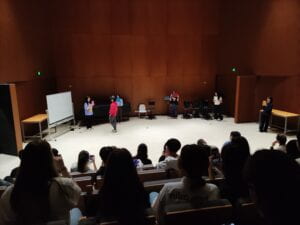
I think it does not well meet the criteria of the assignment. Although Goggle meets the established form of interaction I identified in my research, it doesn’t meet the universe of the story “The Ones Who Walk Away from Omelas” because people in Omelas should be mostly happy, but in their performance, most people goggle detected were feeling negatively and always complained about their schoolwork, which does not make sense to Omelas. Moreover, they didn’t perform the possible new problems caused by Goggle, which should be easy to think of, the loss of privacy. Adding to that, their performance didn’t show the purpose of the artifact clearly. As humans, most of us can easily tell others’ feelings through facial expression, so the Goggle’s functions are not for the masses. Goggle should be used on those who are born with disability to detect others’ moods, but their performance didn’t demonstrate that. The user of Goggle went to each person and said something to comfort them, I think a normal person can do that too without Goggle. Last but not the least, their performance didn’t display the basic function of Goggle, mood detecting. The user asked other performance “What your feeling?” at the beginning of their performance, which actually weakened the function of Goggle. Since you knew their feeling, why did you ask them again? Therefore, their script is not logical enough.
For their creativity, I think mood detector is not a new idea, especially for the one which only detects mood and does not do other things. However, their artifact uses color to represent one’s mood, which I think is quite a creative idea. As for their performance, I think they showed their artifact clearly, but in a quite boring way. They only have one-to-one conversation, which is not appealing.
To improve their group project, I think they can revise their script to perform a more complex story. For example, the user of Goggle may detect the extremely upset kid in Omelas and call for a rescue. Moreover, they can set the user as one who can’t detect mood since he was born, which adds more purpose for Goggle. Other than that, they can have more conversations with different characters, to make the performance more vivid.
My Contribution to the Group
I acted as the bully in the performance and helped turn the mirror around.
I attended every meeting of the group and gave several creative ideas for the project to make it more feasible. For example, I recommended to use a horsehead to replace a whole horse and use the turning chair to turn the mirror.
I made the prop, the cardboard horsehead, with Cajigal, Serena and Gao, Jingchen. Serena and I made most parts of the horsehead and glued them with tapes and hot glue gun and Jingchen drew and cut the sides of the horsehead.
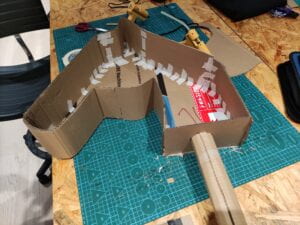
Our reference
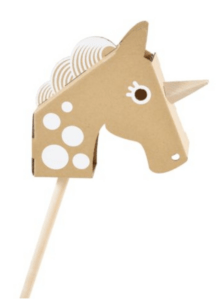
https://www.pinterest.com/pin/352758583313082437
The final prop
Teamwork atmosphere
Our teamwork was really dynamic. Everyone contributed to group project and attended every group meeting. The communication within the team was good. We communicated through WeChat, and everyone replied to the messages quickly.
Here is a photo of the group after performance:
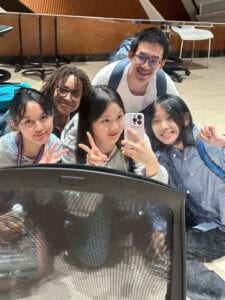
Nicole was busy so she didn’t take a photo with us:(
The different roles
Jiaxiang: Bully
Jingran : 12(years old kid)
Serena : 8(years old kid)
Yihan : Parent 2
Nicole : Parent 1
Roman : Horse (the man riding a horse)
The task allocations
prop(horsehead): Jiaxiang, Serena, Jingran
the artifact’s painting: Serena, Jingran, Yihan, Nicole, Roman
purchase the mirror: Jingran
script: Roman
Idea: Nicole
performance: Serena, Jingran, Yihan, Nicole, Roman, Jiaxiang